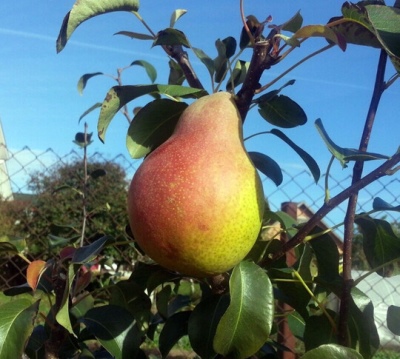
- Authors: Sedov E.N., Krasova N.G., Mikheeva M.V., Parshin A.V., Glazova N.M. (FGBNU VNII Selection of fruit crops)
- Appeared when crossing: Bere winter Michurina x Forest beauty
- Year of approval: 2002
- Fruit weight, g: 140
- Ripening terms: early winter
- Fruit picking time: September 15-20
- Growth type: vigorous
- Yield: high
- Marketability: high
- Crown: wide pyramidal, medium density
Most summer residents and farmers try to plant fruit trees, in particular pears, which are characterized by early maturity and excellent yields. These include the early winter pear species called Lyra.
Breeding history
Pear Lira is the creation of a group of Russian scientists from the All-Russian Research Institute for Breeding Fruit Crops (E. N. Sedov, M. V. Mikheeva, A. V. Parshin, N. G. Krasov). This species was bred in 2000 by crossing two popular varieties - Bere Zimnaya Michurina and Lesnaya Krasavitsa. The variety is zoned in the Central and Central Black Earth regions. The fruit crop was added to the State Register of Breeding Achievements of the Russian Federation in 2002.
Description of the variety
Pear Lira is a tall tree that grows very quickly. The fruit crop is characterized by a wide-pyramidal crown shape with moderate thickening of dark green foliage, arcuate shoots of medium thickness, brownish-brown color, conical buds, white flowers collected in fluffy inflorescences. The fruits are tied with ringlets and spears.
Fruit characteristics
Pear Lira belongs to the large-fruited class. On average, the weight of a pear is 140 grams, but under favorable conditions the fruit reaches 200-250 g. The shape of the fruit is correct - elongated pear-shaped, sometimes with a slight bevel on one side. The fruit stem is short, so they can fall off in strong winds. The peel of pears is smooth, dull and dry, on which numerous, grayish-green dots are clearly visible. Ripe pears have a light yellow color, diluted on one side with a pink blush.
The advantage of fruits is their transportability and long shelf life (3-4 months). The purpose of the fruits is universal, therefore they are eaten fresh, processed into puree, drinks, jam, and can also be preserved.
Taste qualities
Taste qualities, as well as marketable ones, are excellent for this species. The snow-white pulp of the fruit is endowed with firmness, fine grain and excellent juiciness. The taste is dominated by pleasant sweetness with a slight sourness. The aroma of pears is of low intensity, but very pleasant.
Ripening and fruiting
The Lyre pear tree belongs to the early winter species. The tree begins to bear fruit at the age of 6. Fruit ripens on the tree in the second half of September. The consumer period lasts from the first week of October to the end of the year. The pear bears fruit regularly.

Yield
The yield indicators of the tree are excellent. On average, about 80 kg of fruit can be harvested from one pear. On farmlands, trees growing on 1 hectare yield 71 centners of juicy and sweet pears.
Growing regions
The fruit crop grows well in central Russia, throughout Ukraine and in the southern part of Belarus. Applying a number of agrotechnical techniques, the variety can be grown in more northern latitudes.
Self-fertility and the need for pollinators
The Lyra tree belongs to the self-fertile class, but several other varieties of pears planted nearby, in which the flowering time coincides with this species, will not interfere, since this contributes to an increase in yield indicators.
Landing
You can plant seedlings in autumn and spring, but autumn trees begin to bear fruit a little earlier. In spring, planting is carried out in late March - early April, and in autumn - 22-26 days before the first frost. When planting trees, it is recommended to maintain a distance of 4 or 5 meters between them.


Growing and care
The best is loamy or sod-podzolic soil. The main thing is that the area where the Lyre pear will grow is well lit by the sun, then the fruits on the tree will be sweet. A good irrigation system should be installed on the site. Groundwater must run deep.
Comprehensive care consists of a number of manipulations: regular watering, weed control, fertilization (spring, autumn, summer), protection from viruses and insects. The Lyre tree is crown-forming, so no special pruning is required. It is recommended to thin out the foliage in the first few years, as well as sanitary pruning twice a year. In addition, the tree is prepared for winter: the trunk and branches are whitewashed with lime, and the near-stem zone is mulched.



Disease and pest resistance
The pear is resistant to scab, but can be prone to other diseases such as rust, fruit rot, and fire blight. As a preventive measure, treatments in spring and autumn with special preparations (10% urea solution) are effective. From insect pests (aphids, pear mites and flower beetles), treatment with insecticidal preparations will be a reliable protection. During active fruiting, processing cannot be carried out.

Like any other fruit trees, the pear needs protection from various diseases and pests. When planting a pear on your site, you need to know in advance what diseases you should beware of. To successfully carry out the struggle, it is necessary first to correctly identify the cause of the problem. It is important to distinguish signs of disease from manifestations of the presence of insects, mites, caterpillars and other types of pests.
Resistance to soil and climatic conditions
The stress resistance of the fruit tree is average. Low frost resistance is characteristic, as well as the fear of sudden temperature fluctuations. The tree is thermophilic, therefore it requires a lot of sun, and not shade.





































































